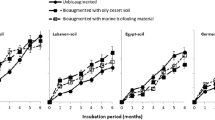Abstract
Biofouling material samples from the Arabian (Persian) Gulf, used as inocula in batch cultures, brought about crude oil and pure-hydrocarbon removal in a mineral medium. Without any added nitrogen fertilizers, the hydrocarbon-removal values were between about 10 and 50 %. Fertilization with NaNO3 alone or together with a mixture of the vitamins thiamine, pyridoxine, vitamin B12, biotin, riboflavin, and folic acid increased the hydrocarbon-removal values, to reach 90 %. Biofouling material samples harbored total bacteria in the magnitude of 107 cells g−1, about 25 % of which were hydrocarbonoclastic. These numbers were enhanced by NaNO3 and vitamin amendment. The culture-independent analysis of the total bacterioflora revealed the predominance of the gammaproteobacterial genera Marinobacter, Acinetobacter, and Alcanivorax, the Flavobacteriia, Flavobacterium, Gaetbulibacter, and Owenweeksia, and the Alphaproteobacteria Tistrella, Zavarzinia, and others. Most of those bacteria are hydrocarbonoclastic. Culture-dependent analysis of hydrocarbonoclastic bacteria revealed that Marinobacter hydrocarbonoclasticus, Dietzia maris, and Gordonia bronchialis predominated in the fouling materials. In addition, each material had several more-specific hydrocarbonoclastic species, whose frequencies were enhanced by NaNO3 and vitamin fertilization. The same samples of fouling materials were used in four successive crude-oil-removal cycles without any dramatic loss of their hydrocarbon-removal potential nor of their associated hydrocarbonoclastic bacteria. In the fifth cycle, the oil-removal value was reduced by about 50 % in only one of the studied samples. This highlights how firmly biofouling materials were immobilizing the hydrocarbonoclastic bacteria.







Similar content being viewed by others
References
Al-Awadhi H, Dashti N, Kansour M, Sorkhoh N, Radwan S (2012) Hydrocarbon-utilizing bacteria associated with biofouling materials from offshore waters of the Arabian Gulf. Int Biodeter Biodegr 69:10–16
Al-Mailem DM, Eliyas M, Radwan SS (2013) Enhanced bioremediation of oily hypersaline coastal areas in Kuwait via vitamin-fertilization. Environ Sci Pollut Res 21:3386–3394
Altschul SF, Madden TL, Schäffer AA, Zhang J, Zheng Z, Miller W, Lipman DJ (1997) Gapped BLAST and PSI-BLAST: a new generation of protein database search programs. Nucleic Acids Res 25:3389–3402
Anon (1979) BP statistical review of the world oil industry. British Petroleum Company, London
Church MJ, Björkman KM, Karl DM (2008) Regional distributions of nitrogen-fixing bacteria in the Pacific Ocean. Limnol Ocean 53:63–77
Diaz MP, Boyd KG, Grigson ST, Burgess JG (2002) Biodegradation of crude oil across a wide range of salinities by an extremely halotolerant bacterial consortium MPD-M, immobilized onto polypropylene fibers. Biotechnol Bioeng 79:145–153
El Samra MI, Emara HI, Shunbo F (1986) Dissolved petroleum hydrocarbons in the Northwestern Arabian Gulf. Marin Poll Bull 17:65–68
Harwati TU, Kasai Y, Kodama Y, Susilaningsih D, Watanabe K (2007) Characterization of diverse hydrocarbon-degrading bacteria isolated from Indonesian seawater. Microb Environ 22:412–415
Hunter JR (1982) The physical oceanography of the Arabian Gulf: a review and theoretical interpretation of previous observations. In: Halwagy R, Clayton D, Behbehani M (eds) The first Arabian Gulf conference on environment and pollution. Kuwait University, Faculty of Science, Kuwait, pp 1–23
Jones KL, Rhodes-Roberts M (2008) Physiological properties of nitrogen scavenging bacteria from the marine environment. J Appl Microbiol 49:421–433
Klug J, Markovetz J (1971) Utilization of aliphatic hydrocarbons by micro-organisms. Adv Microb Physiol 5:1–39
Leahy JG, Colwell RR (1990) Microbial degradation of hydrocarbons in the environ. Microbiol Rev 54:305–315
Marchand M, Monfort JP, Rubio AC (1982) Distribution of hydrocarbons in water and marine sediments after the Amoco Cadez and Istoc. 1. Oil spills. In: Keith L (ed) Energy and environmental chemistry, vol. 1. Arbor Science, MI, pp:487–509
McKinnon M, Vine P (1991) Tides of war: eco-disaster in the Gulf. Boxtree Limited, London
Radwan SS (2008) Microbiology of contaminated desert soils and coastal areas in the Arabian Gulf. In: Dion P, Nautiyal CS (eds) Microbiology of extreme soil, vol 13, Soil Biology. Springer Verlag, Berlin, pp 275–298
Radwan SS, Al-Muteirie AS (2001) Vitamin requirements of hydrocarbon-utilizing soil bacteria. Microbiol Res 155:301–307
Radwan S, Mahmoud H, Khanafer M, Al-Habib A, Al-Hasan R (2010) Identities of epilithic hydrocarbon-utilizing diazotrophic bacteria from the Arabian Gulf coasts, and their potential for oil bioremediation without nitrogen supplementation. Microb Ecol 60:354–363
Rosenberg E (2006) Hydrocarbon-oxidizing bacteria. In: Dworkin M, Falkows S, Rosenberg E, Schleifer KH, Stackebrandt E (eds) The prokaryotes—a handbook on the biology of bacteria, vol 2, 3rd edn. Springer, Berlin, pp 564–577
Santegoeds CM, Ferdelman TG, Muyzer G, Beer D (1998) Structural and functional dynamics of sulfate-reduction populations in bacterial biofilms. Appl Environ Micorbiol 64:3731–3739
Sen Gupta R, Kureishy TW (1981) Present stage of oil pollution in the northern Indian Ocean. Marin Poll Bull 12:295–301
Sorkhoh NA, Ghannoum MA, Ibrahim AS, Stretton RJ, Radwan SS (1990) Crude oil and hydrocarbon degrading strains of Rhodococcus rhodochrous isolated from soil and marine environments in Kuwait. Environ Poll 65:1–17
Swofford DL (1998) PAUP*. Phylogenetic analysis using parasimany (* and other methods), version 4b10. Sinauer Association, Sunderland, MA
Yakimov MM, Timmis KN, Golyshin PN (2007) Obligate oil-degrading marine bacteria. Curr Opin Biotechnol 18:257–266
Yu W, Dodds WK, Banks K, Skalsky J, Staruss E (1995) Optimal staining and sample storage time for direct microscopic enumeration of total and active bacteria in soil with two fluorescent dyes. App Environ Microbiol 61:3367–3372
Acknowledgments
This work has been supported by Kuwait University, Research grant YS03/12. We acknowledge the use of ABI 3130xl Genetic Analyzer and the GLC equipment under the General Facility projects GS01/02 and GS02/01.
Author information
Authors and Affiliations
Corresponding author
Additional information
Responsible editor: Robert Duran
Rights and permissions
About this article
Cite this article
Al-Mailem, D., Kansour, M. & Radwan, S. Bacterial communities associated with biofouling materials used in bench-scale hydrocarbon bioremediation. Environ Sci Pollut Res 22, 3570–3585 (2015). https://doi.org/10.1007/s11356-014-3593-1
Received:
Accepted:
Published:
Issue Date:
DOI: https://doi.org/10.1007/s11356-014-3593-1




